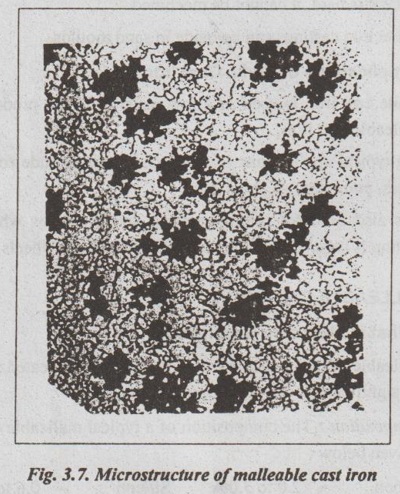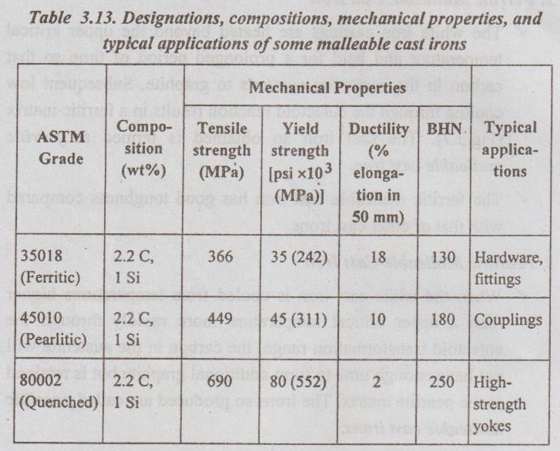Malleable iron is a cast iron that has been heat treated so that it has significant ductility and malleability.↑
MALLEABLE CAST IRON
1. What is Malleable Cast Iron?
✓ Malleable iron is a cast iron that has been heat treated so that it has significant ductility and malleability.↑
✓ Composition: The composition of a typical malleable cast iron is given below:
Carbon - 2.0 to 3.0%
Silicon - 0.6 to 1.3%
Manganese - 0.2 to 0.6%
Phosphorus - 0.15%
Silicon - 0.10%
Remaining is iron
2. Microstructure of Malleable Cast Iron
✓ Malleable iron is produced by heat treating unalloyed (2.5% C, 1.5% Si) white iron. During the heat treatment process, the cementite in the white cast iron structure breaks down into ferrite and graphite clumps (or nodules). This graphite nodules, also called tempered carbon, appears like poncorn. This rounded graphite shape permits a good combination of strength and ductility.
† For the meaning of these terms, refer Unit 5, Section 5.1.
✓ The structure of a typical malleable iron is shown in Fig.3.7.

3. Types of Malleable Irons
Two types of malleable irons, depending on the type of heat treatment cycle used to produce, are:
1. Ferritic malleable iron, and
2. Pearlitic malleable iron.
1. Ferritic Malleable Cast Iron
✓ The white iron castings are heated beyond the upper critical temperature and held for a prolonged period of time so that carbon in the cementite converts to graphite. Subsequent low cooling through the eutectoid reaction results in a ferritic matrix (Fig.3.7). The cast iron so obtained is termed as ferritic malleable cast iron.
✓ The ferritic malleable cast iron has good toughness compared with that of other cast irons.
2. Pearlitic Malleable Cast Iron
✓ When the white cast iron is cooled from temperatures higher than a upper critical temperature more rapidly through the eutectoid transformation range, the carbon in the austenite will not have enough time to form additional graphite but is retained in the pearlite matrix. The irons so produced are called pearlitic malleable cast irons.
✓ Pearlitic malleable cast iron is characterised by higher strength and lower ductility than ferritic malleable cast iron.
4. Designation of Malleable Cast Iron
✓ The designation system for malleable cast iron given by ASTM, is a five-digit number.
✓ The first three digits represents the minimum yield strength in psi of the iron, and the last two digits represents the percent of elongation.
✓ For example, a grade 32510 malleable cast iron has a minimum yield strength of 32.5 × 103 (≈ 224 MPa) psi and 10% elonga- tion; and a grade 35018 has a minimum yield strength of 35 × 103 psi (≈ 242 MPa) and 18% elongation.
✓ Table 3.13 presents the typical compositions, and mechanical properties of some malleable cast irons.

5. Characteristics of Malleable Cast Iron
The important properties of malleable cast iron are given below:
1. The malleable cast iron possess good ductility and malleability properties than grey cast iron.
2. It exhibits high yield strength and tensile strength.
3. It is not brittle as grey cast iron.
4. It has high Young's modulus and low coefficient of thermal expansion.
5. It exhibits excellent impact strength and fatigue strength.
6. It has good wear resistance and vibration damping capacity.
7. It also has excellent machinability.
6. Applications of Malleable Cast Iron
✓ Malleable cast irons are widely used in the automobile industries, because of their combination of castability, shock- resistance, and good machinability. Typical components include brake-shoes, pedals, levers, wheel-hubs, axle-housings, connecting rods, transmission gears, and door hinges.
✓ They are also suitable for the manufacture of thin sections which require high ductility. Typical components include pipe fittings, parts for agricultural machinery, switchgear equipment, and fittings for bicycle and motorcycle frames.
No comments:
Post a Comment